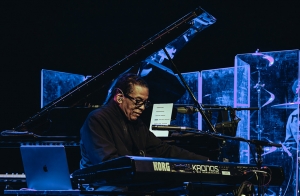Melbourne International Jazz Festival
Building on the success of the 2022 Melbourne International Jazz Festival (MIJF) – never guaranteed, coming off Melbourne’s lockdowns – the MJIF’s artistic team, at first glance, looked to have voted for more of the same, casting a wide net to ensure that plenty of musical diversity was on offer. After the triumph of last year’s Big Saturday event at Sidney Myer Music Bowl, featuring New Zealand funksters Fat Freddy’s Drop, the Festival rebranded this year’s event Jazz at the Bowl, headlined by 1980s soul diva Chaka Khan and funk producer Nile Rodgers, best known for his pioneering work with Diana Ross and David Bowie.
... (read more)'Melbourne International Jazz Festival: The state of jazz in Australia' by Des Cowley
The pandemic was always destined to cast a long shadow, leaving promoters and festivals twitchy when it came to long-term planning. The Melbourne International Jazz Festival (MIJF), like so many other events, swallowed a bitter pill in 2021, as the city went into its sixth lockdown just weeks out, scuttling months of preparation. A quick scramble saw a scaled-back, hastily assembled program of exclusively local acts rolled out over a weekend in December, a temporary marker signalling that the MIJF was down but far from out.
... (read more)It was never going to be a normal Melbourne International Jazz Festival. After all, there was nothing normal about the past two years. Having been forced to cancel in 2020, the festival made the decision to shift the 2021 event from its usual June timeslot to mid-October, perhaps hoping the extra few months might make a difference. The program was duly issued, tickets both offered and sold. Clearly, there would be nothing international about it, though it featured a strong interstate contingent. But in the end, lockdowns ensued, and October came and went. That might well have been the end of it. But, with tenacious resolve, MIJF re-grouped and scheduled a heavily stripped-down program for early December, this time playing it safe by sticking nearly exclusively to local musicians. There were few complaints. Advance bookings were strong in a city long deprived of live music, with some performances selling out within hours of the program’s launch.
... (read more)In 1959, Miles Davis entered Columbia’s 30th Street Studio in New York, with his sextet, and recorded what many consider to be the greatest jazz album of all time: Kind of Blue. It was an inspired idea to program a performance of this music, in celebration of the album’s sixtieth anniversary, at the twenty-second Melbourne International Jazz Festival ...
... (read more)






